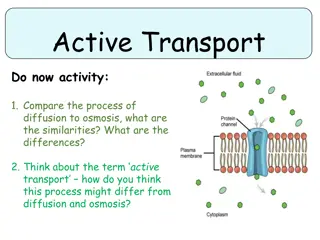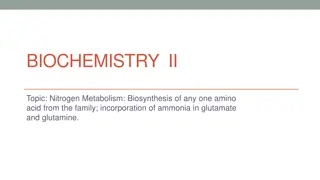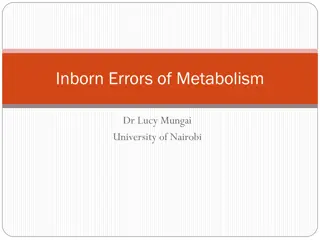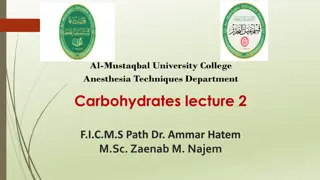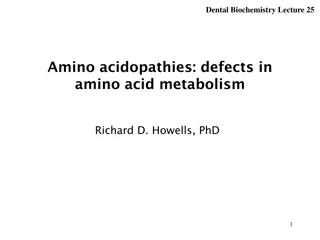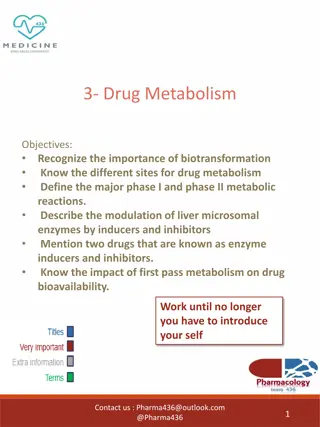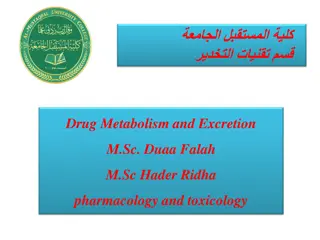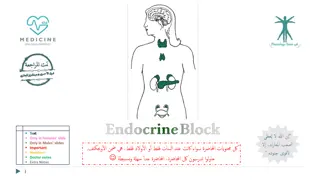
Enzymes and Their Importance in Biological Processes
Discover the role of enzymes in biochemical reactions and how they function as catalysts in living organisms. Learn about the significance of enzymes in maintaining chemical balance, their economic importance, and the conditions affecting their activity. Explore the process of enzyme purification and its implications in various industries.
Download Presentation

Please find below an Image/Link to download the presentation.
The content on the website is provided AS IS for your information and personal use only. It may not be sold, licensed, or shared on other websites without obtaining consent from the author. If you encounter any issues during the download, it is possible that the publisher has removed the file from their server.
You are allowed to download the files provided on this website for personal or commercial use, subject to the condition that they are used lawfully. All files are the property of their respective owners.
The content on the website is provided AS IS for your information and personal use only. It may not be sold, licensed, or shared on other websites without obtaining consent from the author.
E N D
Presentation Transcript
KINGDOOM OF SAUDI ARABIA King Saud University College of Sciences - Department of Botany &Microbiology Metabolism and transport in the plant BOT 379 Dr. Abdulrahman AL-HASHiMi
Lecture 3 Enzymes
Introduction The biochemical reactions that occur in the cells of an organism are similar to the chemical reactions that occur in a test tube in the Lab . Both are subject to the law of matter and energy, and many of these reactions require activation energy. Enzymes are vital catalysts for the reactions that occur in the cells of an organism, and they are often associated with inorganic cofactors such as platinum and nickel.
Enzymes It has been found that it needs less conditions, especially since it works in the tissues of living organisms at body temperature and at a pH similar to the pH of body fluids. Enzymes were defined as organic factors formed by living cells that do not depend on the presence of cells in their work.
Enzymes (The organic catalysts consisting of protein substances formed by living cells and they help speed up certain reactions within a moderate temperature without affecting the equilibrium constant of the reaction, and they work to reduce the activation energy required for the reaction)
Enzymes function Maintaining the balance of the body by controlling its chemical reactions Enzymes reduce the amount of energy needed to start a chemical reaction, and this helps protect them from exposure to high temperatures that lead to the breakdown of the protein structure in the body. Numerous experiments have indicated that all enzymes are proteins in their structure. It was found that high temperatures, alcohols, salts of heavy metals, and concentrated mineral acids cause the enzymes to precipitate and thus lose their activity.
The importance of the Enzymes 1- Enzymes have a very important role in the process of biological catalysis and accelerating the rates of biochemical reactions. 2- Enzymes are of economic importance due to their entry into many food and pharmaceutical industries.
The purification of the Enzymes 1. Molecular Precipitation 2. Adsorption surfactant assembly at a suitable hydrogen head. 3. Polymerization 4. Using high centrifugal force. 5. Using Electrophoresis
The Unit of the Enzymes measurement(IU) It is the amount of enzyme required to convert 1 mole of the substance involved in the reaction per minute into products at a temperature of 30 degrees Celsius and at the appropriate pH for the enzyme.
Structure of Enzymes 1. primary structure Enzymes are made up of amino acids which are linked together via amide (peptide) bonds in a linear chain. This is the primary structure. The resulting amino acid chain is called a polypeptide or protein. The specific order of amino acid in the protein is encoded by the DNA sequence of the corresponding gene.
Secondary structure The hydrogen in the amino group (NH2) and the oxygen in the carboxyl group (COOH) of each amino acid can bond with each other by means of hydrogen bond, this means that the amino acids in the same chain can interact with each other. As a result, the protein chain can fold up on itself, and it can fold up in two ways, resulting in two secondary structures.
Tertiary structure As a consequence of the folding-up of the 2D linear chain in the secondary structure, the protein can fold up further and in doing so gains a three-dimensional structure. This is its tertiary structure.
Enzymes that are composed of only protein substances are called simple enzymes. Others call complex enzymes that a two-fold A protein part called Apo Apo- -enzyme enzyme And another part non- protein molecules that connected with protein and the enzymes can not be active without it. These non-protein molecules: a. minerals or ions. Cofactor B. Enzyme organic molecules
These non-protein molecules are usually metals or ions (iron, magnesium, copper) and are present in trace amounts. They are necessary for the reaction, called a cofactor, without which the enzyme cannot function. Other non-protein molecules consist of organic molecules called coenzymes, coenzymes, or coenzymes (CO- enzymes). When a coenzyme is attached, the unit is called a group, and the coenzyme cannot work alone. Many coenzymes consist of vitamins, especially vitamin B. or sugars, so the enzyme cannot perform its work as required if the food does not contain sufficient quantities of these vitamins.
Comparison between the activation energy of inorganic cofactors and organic cofactors such as enzymes: Cofactor energy (calorie/molecule) Colloidal platinum 18000 Catalase enzyme 5500 Also another example where the activation energy required for the acidic hydrolysis of the sucrose molecule was estimated at 25560 calories, while the activation energy required for the hydrolysis of the sucrose molecule in the presence of the sucrose enzyme extracted from yeast was 8700 calories
How the enzymes works enzyme absence A reaction catalyzed by the presence of an enzyme The enzyme reduces the activation energy of the reaction, allowing the largest number of molecules to be hydrolyzed into products by one enzyme molecule.
Living cells produce enzymes and perform their work by modifying other molecules, as they combine with the modified molecules to form a molecule structure in which the chemical reaction takes place, then the enzyme separates without any change occurring to it during the reaction. Substrate: The enzyme complex and the substrate.
In the body of a living organism, there are thousands of enzymes, each of which has a special subject substance that fits perfectly with it. Therefore, enzymes lead to catalysis, and one enzyme molecule can perform its work in full a million times per minute, and the reaction occurs in the presence of the enzyme at a speed faster than the speed of its occurrence without the enzyme by thousands of times and even millions of times.
properties of enzymes They have the properties of proteins and contain one or more active centers called enzyme activity centers Enzymes are effective even at very low concentrations for converting large amounts of reactant into products. It is not affected by the reactions that activate it and is not consumed during the reaction (it combines with the reaction material and then separates at the products). It works in two directions - demolition - construction (reverse). Enzymes can be either simple or compound, and the complex requires non-protein substances to bind to.
It is manufactured continuously and mostly in the form of inactive compounds (pro-enzymes) and is linked with other compounds to become effective enzymes. It works maximally at neutral PH and with a certain limit in an environment (acidic or alkaline). It is affected by several factors (temperature, salts, minerals), which reduces its functionality. Most enzymes are specialized
Factors affecting the degree of enzymatic activity Due to the protein nature of enzymes, they are often sensitive to environmental stimuli. Among these factors that affect the composition and activity of enzymes are the following: 1. The concentration of the substance involved in the reaction 2- Enzyme concentration 3-temperature 4- pH 5- Accumulation of outputs 6- Presence of inhibitors
Any QUESTIONS ?



